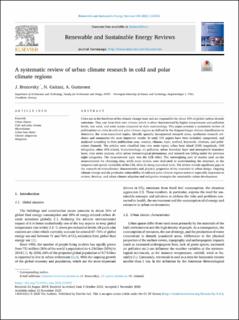| dc.description.abstract | Cities are at the forefront of the climate change issue and are responsible for about 39% of global carbon dioxide emissions. They can form their own climate which is often characterized by higher temperatures and pollution levels, less wind, and solar access compared to their surroundings. This paper presents a systematic review of publications on cities in cold and polar climate regions as defined by the Köppen-Geiger climate classification to determine the most-researched topics, identify sparsely incorporated research areas, synthesize research evidence and summarize the most important results. In total, 101 papers have been included, categorized, and analyzed according to their publication year, country, climate, topic, method, keywords, citations, and publication channels. The articles were classified into nine main topics: urban heat island (UHI) magnitude, UHI mitigation, other UHI related, biometeorology, air pollution, urban boundary layer and atmospheric boundary layer, time series analysis, other urban meteorological phenomena, and research not falling under the previous eight categories. The most-covered topic was the UHI effect. The outweighing part of studies used on-site measurements for obtaining data, while some studies were dedicated to understanding the structure, or the temporal and spatial variability of the UHI, often by using numerical tools. The review reveals significant gaps in the research of microclimatic characteristics and physical properties of the materials in urban design. Ongoing climate change and the particular vulnerability of cold and polar climate regions makes it especially important to review, develop, and adopt climate adaption and mitigation strategies for sustainable urban development. | en_US |

